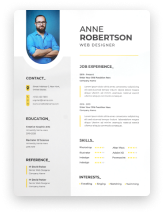In the competitive world of manufacturing and production, having a resume that distinctly highlights your skills and experiences as an assembler can make all the difference. This guide is dedicated to helping you craft an assembler resume that not only showcases your technical abilities but also positions you as the ideal candidate for your next role in the industry. From understanding the nuances of resume formatting to pinpointing the specific skills that employers are looking for, we'll walk you through each step of creating a resume that stands out.

Sample Assembler Resume
Michael Robertson
Assembler
m.robertson@email.com | (555) 123-4567 | LinkedIn: linkedin.com/in/michaelrobertson
Objective
Dedicated and detail-oriented Assembler with over 5 years of experience in automotive manufacturing, seeking to leverage expertise in assembly line work, quality assurance, and team collaboration to contribute to the efficiency and growth of XYZ Motors.
Experience
Senior Assembler, XYZ Motors, Detroit, MI
June 2019 – Present
- Led a team of 10 assembly line workers, achieving a 15% increase in production efficiency while maintaining high-quality standards.
- Developed a streamlined process for parts assembly, reducing assembly time by 20%.
- Conducted regular quality checks, identifying and addressing issues promptly, leading to a 30% reduction in product defects.
Assembler, ABC Manufacturing, Detroit, MI
January 2015 – May 2019
- Assembled automotive parts with precision and attention to detail, following complex blueprints and instructions.
- Collaborated with the quality assurance team to ensure all products met the company's stringent standards.
- Participated in weekly team meetings to discuss ways to improve efficiency and solve production issues.
Education
Certificate in Manufacturing Assembly, Detroit Community College, Detroit, MI, 2014
High School Diploma, Lincoln High School, Detroit, MI, 2013
Skills
- Proficient in using hand tools and assembly equipment.
- Strong understanding of assembly line processes and lean manufacturing principles.
- Excellent teamwork and communication skills.
- Capable of interpreting technical documents and blueprints.
- Adept at performing quality checks and making adjustments as needed.
Certifications
- Certified Production Technician (CPT), Manufacturing Skill Standards Council
Crafting the Perfect Resume Format: A Step-by-Step Guide for Assemblers
Creating a resume that stands out starts with selecting the right format and structure. For assemblers in the manufacturing sector, clarity and precision are just as important on your resume as they are on the production floor. Here's how to structure your resume to highlight your experience and skills effectively:
Choose the Right Resume Format
The chronological format is typically the best choice for assemblers with a steady work history. It allows you to showcase your progression and growth in the field. However, if you're new to the industry or have gaps in your employment, a functional or combination resume might serve you better by focusing on your skills rather than your work history.
Chronological Format Example:
Work Experience
Senior Assembler, XYZ Motors, Detroit, MI
June 2019 – Present
Assembler, ABC Manufacturing, Detroit, MI
January 2015 – May 2019
Header
Start with a clean header including your name, contact information, and professional LinkedIn profile or portfolio link if applicable. Make it easy for hiring managers to contact you without having to search for your details.
John Smith
Assembler
john.smith@email.com | (555) 987-6543 | LinkedIn: linkedin.com/in/johnsmith
John Smith
(555) 987-6543
john.smith@email.com
linkedin.com/in/johnsmith
Objective or Summary Statement
A concise objective or summary at the beginning of your resume can effectively capture the attention of hiring managers. For assemblers, this is your opportunity to highlight your dedication to quality, efficiency, and team collaboration.
Focus on your key strengths and how they align with the job requirements. Keep it concise and impactful.
Work Experience
List your relevant work experience in reverse chronological order. Focus on achievements and responsibilities that relate directly to the assembler role you're applying for. Use bullet points to describe your duties, highlighting any improvements in processes, efficiencies, or quality control measures you contributed to.
Education
While formal education may not always be necessary for assembler roles, any relevant training, certifications, or courses should be listed here. Include the name of the institution, the degree or certification obtained, and the year of completion.
Skills Section
This is crucial for an assembler resume. List both hard skills, such as proficiency in using specific tools or equipment, and soft skills like teamwork and communication. Tailor this section to match the skills mentioned in the job description.
Additional Sections
Consider including sections for certifications, awards, or volunteer experiences that demonstrate your commitment to the field and your community. For example, a certification in Lean Manufacturing Principles can be particularly appealing to employers looking for efficiency improvements.
Beyond the Basics: How to Elevate Your Assembler Resume
While the structure and format of your resume lay the foundation for a strong application, it's the details and how you present your experiences and skills that will set you apart. Here are some additional tips to ensure your assembler resume goes above and beyond:
Quantify Your Achievements
Whenever possible, use numbers to quantify your contributions. For instance, "increased production line efficiency by 15%" is more impactful than "responsible for improving efficiency."
- Developed a streamlined process for parts assembly, reducing assembly time by 20%.
- Helped improve the assembly process and reduce assembly time.
Use Industry-Specific Keywords
Many companies use Applicant Tracking Systems (ATS) to screen resumes before they reach a human. Including relevant keywords and phrases from the job listing can help ensure your resume makes it through these initial screenings.
Review the job description carefully and incorporate key terms and phrases into your resume where appropriate.
Professional Development
Highlight any ongoing learning or professional development initiatives you've undertaken. This shows a commitment to staying current in a rapidly evolving field.
By combining a clear and structured format with detailed, specific content that speaks directly to your experiences and achievements as an assembler, you can create a resume that not only passes ATS screenings but also impresses hiring managers, increasing your chances of landing your next job in the manufacturing sector.
Summarizing Your Assembler Expertise: Crafting a Compelling Resume Summary or Objective
Your resume summary or objective is the first thing hiring managers will read, making it a critical component of your assembler resume. This section should succinctly highlight your most relevant skills, experiences, and career aspirations. Here's how to craft a statement that makes a strong first impression:
Why a Summary or Objective Matters
For Experienced Assemblers
A summary is your opportunity to shine a spotlight on your years of experience, key achievements, and the unique skills you bring to the table. It allows you to stitch together your experiences in a way that presents you as the ideal candidate.
For Newcomers or Career Changers
An objective can demonstrate your enthusiasm and potential, focusing on your transferable skills, your passion for the manufacturing sector, and your career goals.
Crafting Your Statement
Be Specific and Concise
Whether you opt for a summary or objective, keep it to three or four sentences. Clearly state what you can bring to the position and how your background makes you the best fit.
Tailor It to the Job Description
Mirror the language of the job posting to pass ATS scans and align with the employer's needs.
Showcase Your Value
Highlight what you can do for the company. Mention any specialties or areas where you excel, and don't shy away from stating your career goals if they align with the company's direction.
Highlighting Your Work Experience: A Roadmap for Assemblers
The work experience section is where you can truly demonstrate your qualifications and suitability for the assembler role. It's not just about listing your past job titles; it's about showcasing your achievements and the skills you've developed over time. Here are strategies to ensure your work experience stands out:
Structuring Your Work Experience
Use Reverse Chronological Order
Start with your most recent job and work backward. This format is preferred by hiring managers as it provides a clear picture of your career progression.
Emphasize Relevant Experience
Focus on roles and responsibilities that are directly related to assembly work. Highlight your contributions to efficiency improvements, teamwork, and quality control.
Making Your Experience Stand Out
Quantify Your Achievements
Use numbers to make your contributions concrete. For example, "Reduced assembly time by 20% through process optimization."
Highlight Problem-Solving Skills
Demonstrate how you've addressed challenges on the production floor, showing your ability to think on your feet.
Focus on Team Collaboration
Assemblers often work as part of a team. Highlighting your teamwork skills can show potential employers that you'll fit in with their existing team dynamics.
By tailoring your resume's summary or objective and work experience sections to reflect your most relevant skills and achievements, you'll create a compelling narrative that aligns with the needs of potential employers in the manufacturing sector. This targeted approach can significantly increase your chances of moving forward in the hiring process.
Navigating Your Educational Pathway: Tailoring Your Resume for Assembler Roles
When it comes to the education section of your assembler resume, it's about more than just listing your degrees. This section can be a powerful tool to showcase your readiness for the role, especially if you strategically highlight relevant courses, certifications, and training that align with the job requirements. Here's how to effectively present your educational background:
Decoding the Education Section
List Relevant Education
Start with the highest level of education you've completed, such as a degree or diploma. If you have completed relevant coursework or special projects, mention these to demonstrate specific knowledge or skills pertinent to assembly work.
Certifications and Training
In the manufacturing industry, certifications can significantly bolster your application. Include any certifications related to assembly, manufacturing processes, quality control, or safety procedures. This could range from a Certified Production Technician (CPT) to specialized machinery operation certifications.
Continuing Education
If you're engaged in any ongoing training, this can demonstrate your commitment to staying updated with industry standards and technologies. Highlighting this continuous learning can be especially beneficial if you're transitioning from another field.
Equipping Yourself with the Right Skills: The Essential Skills Section for Assemblers
The skills section of your resume should be a finely tuned list of your abilities that are most relevant to the job you're applying for. As an assembler, both hard skills and soft skills are crucial to your success and attractiveness as a candidate. Here's how to identify and present these skills:
Identifying Your Core Skills
Technical Proficiency
Detail any specific tools, machinery, or equipment you're skilled in using. Also, mention any technical processes you're familiar with, such as soldering, welding, or the assembly of particular types of products.
Quality Control and Attention to Detail
Assemblers play a critical role in the manufacturing process, ensuring products meet quality standards. Highlight your experience with quality control measures, inspections, or any techniques you use to maintain accuracy.
Efficiency and Process Improvement
If you have experience optimizing processes to increase efficiency or reduce waste, detail these achievements. This could include implementing lean manufacturing principles or developing new strategies for workflow management.
Teamwork and Communication
Emphasize your ability to work effectively as part of a team, your communication skills, and any experience you have in training or leading others. Collaboration is key in manufacturing environments.
Tailoring Your Skills to the Job Posting
Match the Job Description
Carefully review the job posting to identify the skills emphasized by the employer. Tailor this section to reflect these, using the same language where possible to pass ATS scans and catch the hiring manager's eye.
By carefully crafting your education and skills sections, you can paint a comprehensive picture of your qualifications for an assembler role. Highlighting relevant education, certifications, and a balanced mix of hard and soft skills will demonstrate your readiness to contribute effectively in a manufacturing setting.
Enhancing Your Resume with Additional Sections
To truly set your assembler resume apart from the competition, consider incorporating additional sections that reflect your unique experiences, achievements, or skills. These sections can provide a more holistic view of your candidacy, showcasing your versatility and dedication to your craft. Here's how to leverage additional sections effectively:
Certifications
Industry-Specific Certifications
Highlight any additional certifications you have obtained that are relevant to assembly work or the manufacturing industry. This could include safety certifications, lean manufacturing principles, or specialized equipment operation. Certifications can serve as proof of your commitment to maintaining high standards in your work.
Awards and Recognitions
Acknowledgements of Excellence
If you've received awards or recognitions, either from previous employers or professional organizations, include these in your resume. Awards for productivity, quality, or innovation are particularly relevant and can significantly enhance your profile.
Volunteer Experience
Community Engagement and Skills Application
Volunteer experiences, especially those that involve skills applicable to assembly or manufacturing work, can be a valuable addition to your resume. They demonstrate a willingness to apply your skills in different contexts and a commitment to community service.
Projects
Relevant Projects
If you've worked on any projects, either independently or as part of your previous employment, that demonstrate your skills and knowledge in assembly or manufacturing, include brief descriptions of these projects. This could include process improvements you've implemented, product development projects, or collaborations with other departments to enhance efficiency.
Crafting a Cover Letter That Complements Your Assembler Resume
Your cover letter is an essential companion to your resume, offering you the opportunity to expand on your experiences and express your enthusiasm for the assembler role. Here's how to write a cover letter that complements your resume and engages the hiring manager:
Personalization and Research
Tailor to the Company
Show that you've researched the company and understand its challenges and goals. Explain why you're excited about the opportunity and how your skills and experiences make you an ideal fit for their team.
Highlight Key Experiences
Expand on Your Resume
Use your cover letter to delve deeper into particular experiences or achievements mentioned on your resume. This is your chance to tell the story behind the bullet points, demonstrating your problem-solving skills, teamwork, and commitment to quality.
Express Your Passion
Why Assembly Work
Share why you're passionate about assembly work and the manufacturing industry. Your enthusiasm can be a powerful differentiator, making your application memorable.
By adding thoughtful additional sections to your resume and crafting a compelling cover letter, you're not just submitting an application—you're telling your professional story. These elements allow you to present a rounded picture of who you are as a professional and what you bring to the table, increasing your chances of landing your next role as an assembler.
Key Takeaways for Crafting an Unforgettable Assembler Resume
Crafting an effective assembler resume requires a balance of showcasing your technical skills, work experience, and the unique qualities you bring to the table. Remember, your resume is more than a list of qualifications; it's a reflection of your professional story and your potential as a valuable team member. Here are the key takeaways to ensure your resume stands out:
- Tailor Your Resume: Customize your resume for each job application, highlighting the experiences and skills most relevant to the assembler role you're applying for.
- Quantify Achievements: Use numbers to demonstrate the impact of your work, such as efficiency improvements or reductions in product defects.
- Highlight Relevant Skills: Emphasize both hard and soft skills, showcasing your technical abilities and your capacity for teamwork and communication.
- Include Additional Sections: Certifications, awards, volunteer experience, and relevant projects can differentiate your resume, showing a well-rounded and committed professional.
- Craft a Compelling Cover Letter: Your cover letter is an opportunity to narrate your professional journey and express your enthusiasm for the role and the company.
By following these guidelines, you're not just applying for a job; you're making a strong case for your candidacy as an assembler. Your resume and cover letter should work together to tell a compelling story of your professional journey, your achievements, and how you can contribute to your future employer's success.

Frequently Asked Questions about Assembler Resumes
Q1: How can I make my assembler resume stand out?
Focus on tailoring your resume to the job description, quantifying your achievements, and highlighting relevant skills and certifications. A well-structured, clear, and concise resume that speaks directly to the needs of the employer will stand out.
Q2: What if I don't have much work experience?
Focus on transferable skills, relevant coursework, projects, or volunteer work that demonstrates your abilities and work ethic. Use a functional resume format to highlight your skills and potential.
Q3: Should I include a cover letter with my assembler resume?
Yes, a cover letter allows you to further personalize your application, share your enthusiasm for the role, and provide additional context for your resume. It's a crucial tool for making a strong impression on potential employers.
By addressing these questions and adhering to the key takeaways outlined above, you're well on your way to creating an assembler resume that not only captures the attention of hiring managers but also effectively communicates your value as a candidate.
Remember, the goal of your resume is to paint a comprehensive picture of your qualifications and potential. By tailoring your content to the specific needs of the employer, using clear and concise language, and highlighting your most relevant experiences and skills, you can create a resume that sets you apart from other candidates and increases your chances of securing your next role in the manufacturing industry.
Recommended Reading









